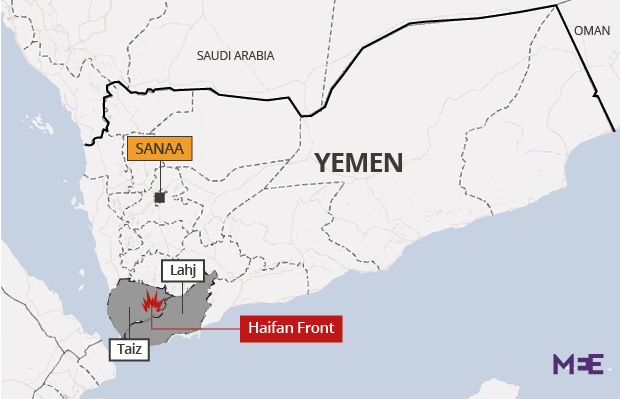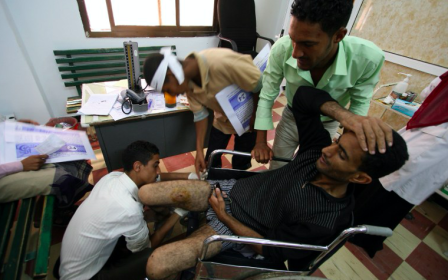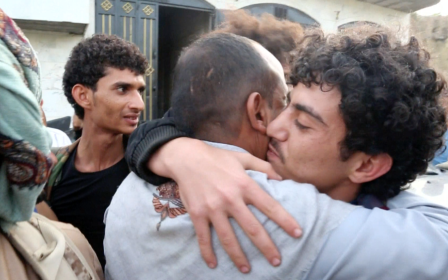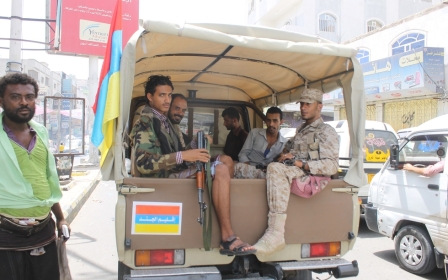Penniless Yemeni fighters desert front in droves as Hadi fails to pay up
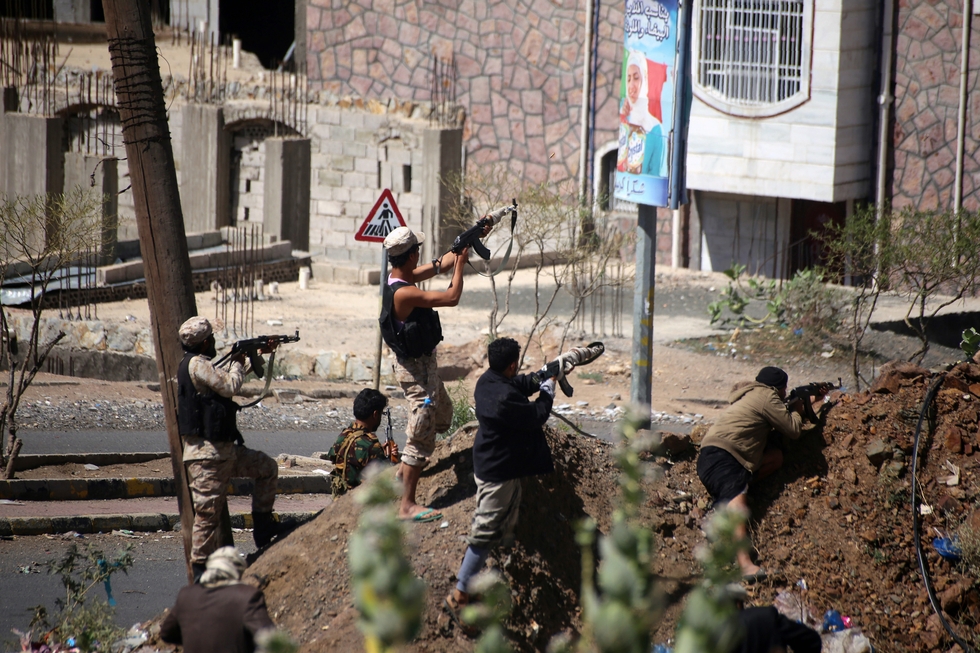
TAIZ, Yemen – When the Houthi militias stormed south to Taiz in southern Yemen, 36-year-old Zakarya al-Aswad took up arms to try and root them out.
For more than a year, he fought with the Popular Resistance, which supports the government of President Abd Rabbuh Hadi against the rebels.
But then the money ran out and Aswad ditched the frontlines for a very different kind of work: selling propane cylinders.
"When the war broke out in Taiz city, I lost my work in a clothes shop and took my five family members to my original village,” Aswad told Middle East Eye.
“A month later, I decided to join the resistance to liberate my city from the Houthis. I wanted to resume work and get money from the resistance to eke out an income for my family."
New MEE newsletter: Jerusalem Dispatch
Sign up to get the latest insights and analysis on Israel-Palestine, alongside Turkey Unpacked and other MEE newsletters
Aswad says he fought dutifully in many key battles as long as the resistance kept paying him YR2000 ($8) per day. The payments continued for nine months but then, like many other civilian fighters who joined the Popular Resistance, they stopped earlier this year and prompted Aswad to lay down his arms.
These days, he buys propane cylinders from a local market and sells them to residents in his village which earns him YR2500 ($10) a day, some 20 percent more than he earned risking his life on a daily basis.
"The resistance stopped paying civilian fighters on several battle fronts, including [the strategically key battleground in] Haifan,” Aswad said.
Haifan is a district in Taiz province that borders Taiz city to the south and stretches to the neighbouring province of Lahj - the latter is a key supply route to the southern port city of Aden, which was taken back from the Houthis last summer.
“At the same time [as our money was cut], the soldiers continued to get money from the resistance and this created a dispute between the leadership and the civilian fighters,” Aswad said.
“Hundreds of civilians then started to flee the battle with their Kalashnikovs, while many others - like me - returned the Kalashnikovs to the leadership [and went home]."
According to Nael al-Adimi, a resistance leader in Taiz, some 5,000 of their fighters have left the battle in the last few months, largely due to funding shortages. He said there were about 10,000 armed men left but that he expected further desertions over the coming weeks.
"We do not have enough money to pay all fighters," Adimi said.
Civilians, who make up the majority of the Popular Resistance force, were the first to rise up against the Houthis in March 2015. The army only followed a month later when the bulk of its commanders decided to back Hadi, with smaller factions breaking off and siding with the Houthis and their key ally former President Ali Abdullah Saleh.
While civilian fighters were initially bolstered by army support, and the launch of an anti-Houthi bombing campaign by a Saudi-led coalition of mainly Sunni countries in March 2015, more than 500 days after the international battle for Yemen began, many of the country’s fighters say they have had enough.
For almost a year, Hamoud al-Mikhafi, who led the Popular Resistance in Taiz, borrowed millions of dollars from local traders to supplement the fighters’ salaries, insisting that the money from Saudi Arabia was insufficient. In February, however, he left the country and severed the resistance’s main credit line.
Alliance with Salafis
While the funding flowed, the Popular Resistance was able to hold onto Haifan, despite heavy Houthi pressure. When the fighters began to desert en masse earlier this year, however, the anti-Houthi forces found themselves outmatched and the whole district fell to the Houthis in July.
In desperation, the remaining fighters allied with Salafi militias, who reinforced the front but at a potentially heavy price.
They fiercely oppose the Shia Houthis but do not necessarily support Hadi. Their leader, Abu al-Abbas, has also levelled a 500-year-old mosque because it housed the shrine of a revered Sufi scholar and many residents accused his fighters of supporting al-Qaeda in the Arabian Peninsula (AQAP) which has launched a string of deadly attacks against the government in Aden.
"We know that the Salafis are the strongest fighters and they do not care about money or military reinforcements, but no one can trust that they will not create chaos in Taiz province after the liberation of Taiz," Shawqi Abdullah, a journalist based in Taiz told MEE.
He called on the government to bolster the army and fight to retake Taiz without Salafi support, saying that some resistance groups were "worse than the Houthis" and will never back the government but will "serve their own interests".
Others though are less willing to wait for Hadi and his government, which has largely tried to rule from a self-imposed exile in Saudi Arabia, to take action.
"We have already sold our wives’ jewellery and we are willing to sell our houses, but we will not surrender to the invaders,” Adimi said. “If the government does not support us now, we will not support it later. But in the end Taiz will win the battle.”
A soldier fighting in the Haifan front told MEE on the condition of anonymity that the resistance "depends on the Salafi forces on several fronts”.
“The Houthis stop advancing if they know that they will be confronted by the Salafists so I am calling for the government to support them,” he said.
Fighting for no pay
Aswad, the former fighter, told MEE that he continues to support the resistance and that he believed in the fight to liberate Taiz from "invaders", but said that he simply couldn’t fight for free because his family was threatened with starvation.
“I hope Taiz will be liberated soon. Then I can reopen my shop."
"About 90 fighters, including me, left the Haifan front [south of the city] the same day and went to look for work that would allow us to provide at least a small income for our families,” Aswad said.
Much like Aswad, Hamid al-Mansouri joined the Popular Resistance so that he could fight the Houthis. He took up arms in August 2015, after the Houthis imposed the siege on Taiz city, because he wanted to end the blockade and get his cheese shop up and running again.
"I have a shop in al-Dhabab area [about 10 kilometres west of Taiz city],” Mansouri said. “I used to sell my cheese to passengers who would come and go from Taiz city, but the war reached Dhabab and all the cheese shops have had to close.
“After my shop was closed, I joined the resistance to try and get some money and to try and break the siege and allow travellers to come back to my shop," he added.
After joining up, Mansouri found himself making bullets. When the money dried up this spring though, he said he could no longer justify working for the Popular Resistance and left the fight at the start of July.
Instead, he has gone back to the cheese business, choosing to go to work for a friend who ran a shop further from Taiz city where the fighting has not been as severe and where some business can still take place.
"I am just helping my friend and he pays me YR1000 ($4) per day,” Mansouri said, while stressing that he continues to be a Popular Resistance supporter.
“I hope Taiz will be liberated soon. Then I can reopen my shop."
Middle East Eye delivers independent and unrivalled coverage and analysis of the Middle East, North Africa and beyond. To learn more about republishing this content and the associated fees, please fill out this form. More about MEE can be found here.


